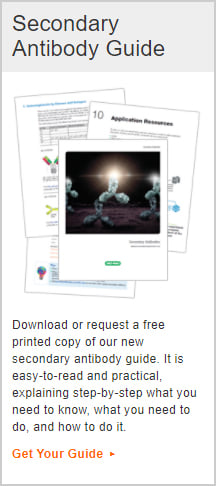Secondary Antibodies – Optimize Your Detection System
A secondary antibody is used to detect an unconjugated primary antibody that has bound to a target antigen.
Secondary antibodies conjugated to enzymes and fluorophores are key components of detection systems and the selection of an optimal secondary antibody can improve the positive signal in addition to reducing false positive or negative staining.
 Further amplification of detection signals may be achieved by the addition of a labeled tertiary antibody which binds to the secondary antibody.
Further amplification of detection signals may be achieved by the addition of a labeled tertiary antibody which binds to the secondary antibody.
Experimental Design – How-to Reference Guide
Experimental design is a critical step to obtaining precise results. To ensure success it is important to consider:
Clonality of the secondary antibody
-
Polyclonal — population of antibodies usually raised in goats, rabbits, sheep or donkeys which recognize many different epitopes on the antibody they are raised against. The signal is then amplified as multiple secondary antibodies bind to the same primary antibody
-
Monoclonal — these antibodies are usually raised in mice or rats. They recognize a single epitope on the antibody they are raised against, therefore they will not give amplification of signal
Target of the secondary antibody
-
Class — IgG, IgA, IgD, IgE and IgM
-
Isotypes — polyclonal secondaries raised against, for example, mouse IgG will have a bias towards reactivity with the most common isotype, in this case IgG1. To get a stronger signal for a rarer isotype, such as IgG2b, it can be advantageous to select a secondary specifically raised against this isotype. Example isotypes are IgG1, IgG2a, IgG2b
-
Chain — while it is often unimportant which part(s) of the primary antibody are epitopes for the secondary antibody, it is possible to choose secondaries raised against specific regions of the heavy chain or against the light chain should this be necessary
-
Heavy for example, Fc domain or hinge region
-
Light for example, kappa or lambda
-
-
Binding location – it is important to consider where on the primary antibody you want the secondary antibody to bind. In the secondary antibody binding location review we have highlighted the different options for binding locations, their benefits, and examples of their applications
Secondary antibody host
Ideally the secondary antibody should be from a host species that is phylogenetically distant from the target species of the primary antibody. This will minimize direct binding of the secondary antibody by Fc receptors on the target tissue or cells, otherwise Fc blocking can reduce this binding.
Target species
In this context it is defined as the host species of your primary antibody. Note some closely related species have very antigenically similar antibodies, which can be exploited, for instance anti-goat IgG antibodies will often cross-react with sheep antibodies.
Cross-adsorbed antibodies
Cross-reactions are often seen in secondary antibodies. For example, anti-mouse IgG may cross-react to some degree with rat IgG, or an anti-rat IgG may show some cross-reaction with IgM, and an anti-mouse IgG2a with mouse IgG2b. In many cases these problems are not significant, but in others a high degree of specificity is required for accurate data
Here the use of a cross-adsorbed secondary is recommended. Unwanted cross-reactivity is removed by pre-adsorption of the secondary antibody with the cross-reacting antigen, to yield a more specific secondary and therefore reducing nonspecific background staining.
Read our overview on cross-adsorbed secondary antibodies to discover why and how you should use them, how they are generated, and a list of the cross-adsorbed secondary antibodies available now.
Controls
Include a secondary only control to ensure that there is no nonspecific staining from the secondary.
Detection reagents
The choice of the detection reagents will depend on the application and the specifics of that particular experiment.
-
ELISA — enzyme-linked secondaries are the most popular choice
-
Flow cytometry — choose a secondary conjugated with a fluorophore
-
Cell or tissue staining — HRP, alkaline phosphatase or a fluorescent-linked secondary antibody
-
Western blotting — enzyme-linked and fluorescently labeled secondaries are best
Example detection reagents:
-
Fluorescent dyes for example, PE and FITC
-
Chemiluminescent for example, HRP
-
Colorimetric for example, alkaline phosphatase
-
Conjugated streptavidin — for use with biotin-labeled primary antibodies
Applications
This is a key component to experimental design and will affect many of the choices to be made in secondary antibody selection. Refer to the antibody selection step-by-step flow chart here.
Indirect staining would involve careful optimization of your experiment, to avoid nonspecific binding. To help with this, Bio-Rad has created a how-to guide so you can achieve the best specific flow staining using secondary detection reagents.
Multiplex unconjugated primary antibodies using secondary antibodies
Multiplexing differentially labeled primary antibodies is not always possible, but with a careful choice of unconjugated primary antibodies in combination with selected secondary antibodies, it can be achieved. There are three main factors to consider: different species, classes, and isotypes.
Click here to learn more about multiplexing using secondary antibodies.
Read our overview on multiplex fluorescent western blotting to learn about the advantages.
Secondary antibody detection of HuCAL® generated antibodies
Human Combinatorial Antibody Library (HuCAL) generated recombinant antibodies, for custom development of novel antibody specificities, can be used in a wide range of immunoassays such as western blotting, immunohistochemistry, ELISA and flow cytometry. Anti-human and anti-tag secondary antibodies of various specificities are ideal for detection of these antibodies; for full details download our resource on Reagents to Support HuCAL Assay Development.
-
When using more than one secondary antibody ensure that they don’t cross-react
-
When working with some immune tissues or cells that contain a lot of Fc receptors, it helps to choose a F(ab) or F(ab’)2 fragment to eliminate nonspecific binding. Alternatively, block Fc receptors via an absorption step, using purified IgG from the host species of your secondary antibody or serum from target cells
-
View our IHC tips when using a secondary antibody
Any questions? Let us help, contact our technical support team for advice
Secondary Antibodies at a Glance
The secondary reagents have been carefully selected to provide optimum quality and flexibility:
-
Monoclonal or polyclonal
-
IgG molecules and F(ab’)2 fragments
-
Available in many formats
-
Wide range of applications including - flow cytometry, immunocytochemistry and western blotting
-
Cross-absorbed antibodies
-
StarBright range products. They are fluorescent, affinity-purified, and have been carefully optimized for specificity and titre
Target |
Host |
Class and Chain |
Conjugates |
|---|---|---|---|
|
Ig IgA, IgA A1, IgA A2, IgA H, IgA secretory chain IgD, IgD H, IgD D IgE IgG, IgG1, IgG2, IgG2a, IgG2b, IgG2c, IgG3, IgG4, IgG H/L, IgG Fc, IgG Fc CH2 domain, IgG CH2 domain, IgG CH3 domain, IgG gamma, IgG Fab, IgG F(ab’)2 IgM, IgM Mu, IgM H IgG/A/M Lamba light chain Kappa light chain J chain |








